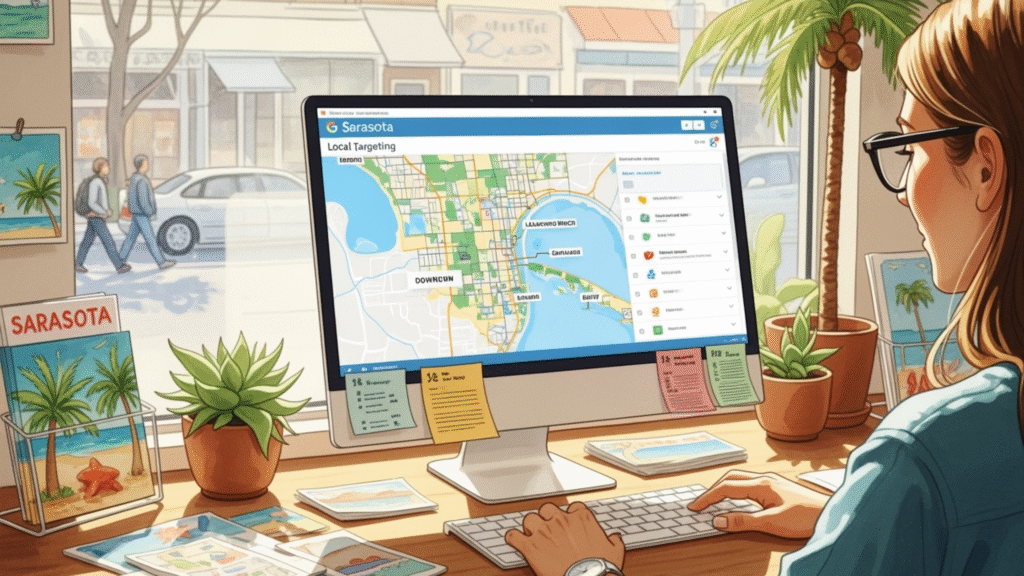In 2025, the digital advertising landscape continues to evolve at a breathtaking pace. Yet, amidst the advancements in AI, programmatic buying, and immersive ad formats, one fundamental strategy remains indispensable, particularly for businesses serving a specific area like Sarasota: geographic targeting. For Sarasota businesses, the ability to deliver highly relevant advertisements to potential customers based on their physical location is not just an advantage; it is the bedrock of efficient and effective digital marketing. This article delves into the power of geographic targeting, exploring its mechanisms, benefits, and practical applications for Sarasota businesses aiming to dominate their local digital advertising space.
Why Geographic Targeting is Crucial for Sarasota Businesses in 2025
The internet has erased many geographical boundaries, making it possible for businesses to reach a global audience. However, for a charming boutique on St. Armands Circle, a popular restaurant in downtown Sarasota, or a trusted plumbing service in Lakewood Ranch, the primary customer base is inherently local. Wasting advertising budget on individuals thousands of miles away, who will never realistically visit your physical location or utilize a localized service, is inefficient and unsustainable.
This is where geographic targeting shines for Sarasota businesses. It allows you to:
Maximize Ad Spend Efficiency: By focusing advertising dollars only on areas where potential customers in Sarasota and its surrounding communities reside or travel, you dramatically reduce wasted impressions and clicks. Every dollar spent works harder.
Increase Ad Relevance: A promotion for a coffee shop’s morning special resonates far more with someone currently within a two block radius of your Sarasota shop than with someone across the state. Location specific messaging makes ads more appealing and actionable for Sarasota residents and visitors.
Drive Foot Traffic and Local Sales: For Sarasota’s many brick and mortar businesses, geographic targeting is a direct pipeline to increasing physical visits and in-store purchases. A study by Google in 2021 found that 76% of people who search for nearby businesses on their phones visit one of those businesses within a day, and 28% of those visits result in a purchase. These figures underscore the power of local intent right here in Sarasota.
Enhance Local SEO Efforts: Consistent use of geographic targeting in digital ads, combined with strong local SEO practices, reinforces your Sarasota business’s local relevance in search engine algorithms, improving visibility in “near me” searches from Lido Key to Palmer Ranch.
Gain a Competitive Edge: Many larger competitors might opt for broad national campaigns. By focusing on hyperlocal precision within Sarasota, local businesses can dominate their immediate market and build stronger community connections.
Personalize the Customer Experience: Geo targeted ads can incorporate local Sarasota landmarks, events, or cultural references, creating a deeper, more personalized connection with your Sarasota audience. This tailored approach fosters loyalty and engagement.
In 2025, with Sarasota consumers increasingly relying on mobile devices for local searches and spontaneous decisions, the ability to pinpoint and engage geographically relevant audiences is no longer an advanced tactic; it is a foundational necessity for any Sarasota business.
Understanding the Mechanics of Geographic Targeting for Sarasota
Geographic targeting, also known as geotargeting, leverages various data points to deliver marketing content to users within a defined geographic boundary. Unlike traditional advertising which relied on broad demographics based on print circulation or broadcast areas, digital geotargeting uses precise technological capabilities.
Key technologies and data points enabling geographic targeting include:
- IP Addresses: The most basic form of geo targeting, IP addresses can identify a user’s general geographic location, often down to the city or postal code level.
- GPS (Global Positioning System): Highly accurate, GPS data from smartphones provides real time location information, crucial for mobile first targeting strategies relevant to Sarasota residents and tourists alike.
- Wi-Fi and Bluetooth: These technologies enable “proximity marketing” within specific, smaller areas like Sarasota shopping malls, event venues, or even within a few meters of a store, delivering messages to devices in close range.
- Cell Tower Triangulation: Less precise than GPS, but useful in areas with limited satellite coverage, this method uses signals from multiple cell towers to approximate a device’s location.
- User Declared Location Data: Information users explicitly provide in their profiles on social media platforms or search engines, such as their home city (e.g., Sarasota) or work location.
- Device ID: Unique identifiers for mobile devices that can be used for persistent targeting and tracking within a geographic area.
Different advertising platforms offer varying degrees of sophistication in their geographic targeting options:
Google Ads: Allows targeting by country, region, city, postal code, or a specific radius around a location. For Sarasota businesses, you can target the city of Sarasota, specific zip codes like 34236 (Downtown) or 34238 (Palmer Ranch), or even a radius around your business on Main Street. Advertisers can also target based on “Presence or Interest,” reaching people currently in the targeted location or those who have shown an interest in it. You can explore Google Ads’ geographic targeting features here.
Facebook and Instagram Ads: Offer highly granular targeting by country, state, city, postal code, or a dropped pin with a customizable radius (from 1 mile up to 50 miles), perfect for pinpointing areas in and around Sarasota. Advertisers can further refine audiences by selecting “Everyone in this location,” “People who live in this location,” “People recently in this location,” or “People traveling in this location,” providing immense flexibility for targeting Sarasota residents, seasonal visitors, or tourists. Learn more about Facebook and Instagram Ads’ targeting capabilities here.
TikTok Ads: Provides location targeting options that allow advertisers to reach users based on country, region, or city, catering to its rapidly growing user base with localized content relevant to Sarasota. Discover TikTok Ads’ targeting options here.
Programmatic Advertising Platforms: These platforms can integrate vast amounts of third party location data with demographic and behavioral information, enabling extremely precise, personalized ad delivery across a multitude of websites and apps, ideal for reaching niche audiences within Sarasota.
Geographic Targeting vs. Geofencing for Sarasota Businesses: A Key Distinction
While often used interchangeably, it is important for Sarasota businesses to understand the difference between geographic targeting and geofencing:
Geographic Targeting (Geotargeting): This is the broader strategy of delivering ads to users based on their location, whether it is their home address, current city, or a broader region. It focuses on who is in a defined area. For example, a restaurant in Sarasota targeting anyone living or recently in the 34236 zip code for a dinner special is using geotargeting.
Geofencing: This is a more precise, real time application of location based marketing. It involves setting up a virtual perimeter, or “geofence,” around a specific physical location (like your store on Siesta Key, a competitor’s store in Lakewood Ranch, or a local Sarasota event venue). When a user’s mobile device enters or exits this geofenced area, it can trigger an ad, push notification, or other message. Geofencing is about reaching people at a specific point in time when they are physically present in a precise location. For example, a coffee shop in downtown Sarasota sending a push notification for a 10% discount to app users who walk within 100 meters of their store is using geofencing.
While geofencing offers incredible precision for driving immediate foot traffic to your Sarasota location, it typically requires users to have an app installed or location services enabled. Geotargeting, being broader, is more versatile for general awareness, branding, and reaching a wider Sarasota local audience interested in your products or services. Many successful local campaigns combine both strategies for maximum impact within the Sarasota area.
Practical Strategies for Sarasota Businesses in 2025
Implementing effective geographic targeting goes beyond simply drawing a circle on a map of Sarasota. It requires strategic thinking and careful execution tailored to the unique aspects of our community.
1. Define Your Hyperlocal Zones within Sarasota
Do not just target all of Sarasota. Think about specific neighborhoods, commercial districts, or even individual blocks that are most relevant to your business in Sarasota and its surrounding areas.
- Service Areas: If you are a service provider (plumber, electrician, home cleaner), target the exact neighborhoods you serve, from Palmer Ranch to Venice.
- Foot Traffic Zones: For retail or restaurants in Sarasota, consider the surrounding blocks, business parks, or residential areas from which you expect foot traffic, such as the bustling areas near St. Armands Circle or Main Street.
- Competitor Locations: Use geofencing to target areas around competitor businesses in Sarasota. This “geo conquesting” strategy can entice customers with a better offer when they are nearby.
- Event Venues: During local Sarasota festivals (like the Sarasota Chalk Festival), concerts, or sporting events at Ed Smith Stadium, target attendees with relevant promotions.
2. Craft Location Specific Ad Copy and Creatives for Sarasota
Generic ads rarely perform as well as those tailored to the local Sarasota context.
- Use Local Modifiers: Include “Sarasota,” “Siesta Key,” “Lakewood Ranch,” or even local landmarks like “Marie Selby Botanical Gardens” or “The Ringling Museum” in your ad headlines and body copy. For example, “Best Pizza in Downtown Sarasota!” or “Your Trusted Plumber in Lakewood Ranch.”
- Reference Local Events: If there is a local Sarasota fair, arts festival, or sports game, create ads that tie into that event, such as “Grab a burger before the Orioles game!”
- Show Local Imagery: Use photos or videos that feature recognizable Sarasota landmarks or show people enjoying your product or service within the Sarasota community.
- Tailor Offers: Offer promotions that are relevant to local Sarasota tastes or current local needs, perhaps a special for snowbirds in winter or a beach ready discount in summer.
3. Leverage Different Ad Platforms Strategically for Sarasota
Each platform offers unique advantages for geographic targeting in Sarasota:
Google Ads (Search and Display): Ideal for capturing “near me” intent. Optimize your Google Business Profile for your Sarasota location, use location extensions in your ads, and bid strategically on local Sarasota keywords (e.g., “Sarasota dentist,” “Lakewood Ranch restaurants”). For display ads, target specific geographic areas within Sarasota with visually appealing creatives.
Social Media Ads (Facebook, Instagram, TikTok, X): Excellent for audience layering. Combine geographic targeting with demographic and interest based targeting to reach specific Sarasota groups. For instance, target “new homeowners in the 34202 zip code” with ads for home improvement services. Use Facebook’s “Store Traffic” objective to optimize for in store visits in Sarasota.
Mobile Advertising Networks: Explore specialized mobile ad networks that offer precise location data and can deliver ads via apps or mobile websites when users are in a specific area of Sarasota.
Programmatic Advertising: For more sophisticated campaigns, programmatic platforms allow for highly granular geographic targeting across a vast network of websites and apps, often integrating with first party customer data for hyper personalization relevant to Sarasota’s diverse population.
4. Optimize for Mobile Users in Sarasota
The vast majority of local searches in Sarasota happen on mobile devices. Ensure your ads, landing pages, and website are mobile friendly and load quickly. Enable click to call buttons and clear directions to your physical Sarasota location.
5. Integrate with Local SEO for Sarasota
Geographic targeting in digital ads complements your local SEO efforts for your Sarasota business.
- Google Business Profile (GBP): Keep your GBP listing fully optimized for your Sarasota location, with accurate business hours, address, phone number, photos, and customer reviews. This is critical for appearing in local search results and map packs, which are heavily influenced by proximity.
- Local Citations: Ensure consistent Name, Address, Phone (NAP) information across all online directories and platforms relevant to Sarasota.
- Location Specific Content: Create blog posts or website pages that cater to local Sarasota interests, using local keywords. For example, “Top 5 Family Restaurants in Sarasota” or “Best Hiking Trails Near Lakewood Ranch.”
- Local Reviews: Actively encourage Sarasota customers to leave reviews on Google, Yelp, and other relevant platforms, as these significantly impact local search rankings and consumer trust.
6. Monitor, Test, and Refine Your Sarasota Campaigns
Digital advertising is not a “set it and forget it” endeavor. Continuously monitor your campaign performance for your Sarasota targeting.
- Track Key Metrics: Pay attention to click through rates (CTR), conversion rates (online and offline), cost per click (CPC), and foot traffic (if measurable) from your Sarasota focused ads.
- A/B Test: Experiment with different ad copy, creatives, and geographic boundaries within Sarasota to see what resonates best with specific local segments.
- Analyze Geographic Performance: Use analytics to identify which specific areas within Sarasota are generating the most leads or sales and adjust your budget allocation accordingly. You might discover that a seemingly less obvious neighborhood yields excellent results.
- Adapt to Local Trends: Stay informed about local Sarasota events, holidays, and community happenings, and adjust your ad campaigns to be timely and relevant.
Future Trends in Geographic Targeting for Sarasota Businesses (2025 and Beyond)
As technology advances, geographic targeting will become even more sophisticated for Sarasota businesses:
Hyper Personalization at Scale: AI will enable real time ad customization not just based on location, but also on a user’s immediate context, past behaviors, and even predicted needs, all within a precise geographic zone in Sarasota. Imagine an ad for a specific umbrella brand appearing on your phone only when you are in downtown Sarasota and it just started raining.
Privacy First Location Data: With increasing privacy regulations (like the ongoing evolution of GDPR and CCPA), the emphasis will shift towards privacy compliant methods of collecting and utilizing location data, often relying more on aggregated, anonymized data or explicit user consent for personalized experiences, particularly relevant for Sarasota’s diverse population.
Integration with IoT (Internet of Things): Smart city initiatives and connected devices could provide new, anonymized data streams for targeting within Sarasota, allowing businesses to understand real time traffic patterns and population density to optimize ad delivery.
Augmented Reality (AR) in Local Ads: Imagine AR overlays on your phone showing a special offer when you point your camera at a store on Main Street in Sarasota. This immersive local advertising is on the horizon.
Voice Search Optimization for Local Intent: As voice assistants become more prevalent, optimizing your content and ads for natural language local queries (e.g., “Hey Google, where’s the closest vegan restaurant in Sarasota?”) will be critical, intertwining local SEO and geographic targeting for Sarasota.
Sarasota businesses that embrace these evolving capabilities will not only reach their local customers more effectively but will also create highly engaging and genuinely useful advertising experiences that foster long term loyalty.
Own Your Local Digital Space in Sarasota
For businesses operating in the Sarasota market, geographic targeting is the cornerstone of effective digital advertising in 2025. It transforms broad, potentially wasteful campaigns into precise, high impact efforts that resonate directly with your most valuable audience: those right here in Sarasota. By leveraging the advanced tools available, crafting locally relevant messages, and continuously refining your strategies, you can not only drive increased foot traffic and sales but also solidify your brand’s position as an integral part of the Sarasota community. In a world of increasing digital noise, relevance cuts through, and geographic relevance is the sharpest tool in your local marketing arsenal.
Is your Sarasota business ready to unlock the full power of geographic targeting?
Don’t let your digital ads get lost in the noise. Communica PRO specializes in crafting highly effective, geographically targeted digital advertising campaigns that connect your Sarasota brand with the right local customers, drive foot traffic, and boost your bottom line.
Contact Communica PRO today for a consultation on how we can optimize your local digital advertising strategy for Sarasota. Visit our website or call us to start reaching your local market with precision.
FAQs About Geographic Targeting in Digital Advertising for Sarasota Businesses
Here are answers to some common questions about using geographic targeting for local digital advertising in Sarasota:
What is geographic targeting in digital advertising for Sarasota businesses?
Geographic targeting, or geotargeting, is a digital advertising strategy that delivers ads to users based on their physical location, such as their city (Sarasota), postal code, or a specific radius around your business. It ensures your ads are seen by potential customers in your Sarasota service area or close to your physical business.
How does geographic targeting help Sarasota businesses?
It helps Sarasota businesses by making their advertising more efficient and effective. By focusing ad spend only on relevant geographic areas like Sarasota and its surrounding neighborhoods, it reduces wasted impressions, increases ad relevance, drives foot traffic to physical locations, boosts local sales, enhances local SEO, and provides a competitive advantage against broader campaigns.
What is the difference between geotargeting and geofencing for Sarasota?
Geotargeting is a broader strategy that targets users within a defined geographic area in Sarasota. Geofencing is a more precise technique that sets a virtual perimeter around a specific Sarasota location (like your store on Siesta Key), triggering ads or notifications when a user’s mobile device enters or exits that exact area. Geofencing is ideal for real time, proximity based engagement in Sarasota.
What platforms allow for geographic targeting for Sarasota businesses?
Most major digital advertising platforms offer robust geographic targeting capabilities. These include Google Ads (for search and display), social media platforms like Facebook, Instagram, and TikTok Ads, as well as various mobile advertising networks and programmatic advertising platforms. Each offers different levels of granularity for targeting Sarasota and nearby areas.
Can Sarasota businesses target very small areas, like a single street or building?
While most platforms allow targeting down to a very small radius (e.g., 1 mile), targeting extremely small areas like a single street or building can sometimes limit your audience too much, potentially making your ads show intermittently or not at all due to insufficient audience size. Geofencing, however, is designed for such precise, real time proximity targeting in Sarasota if users have opted into location services.
How accurate is geographic targeting for Sarasota?
The accuracy depends on the technology used. IP address targeting is less precise, often identifying location down to a city like Sarasota. GPS data from mobile devices offers high accuracy, often within meters. The effectiveness also depends on user settings, as some users opt out of precise location sharing. However, combined with other data points, it remains highly effective for local advertising in Sarasota.
Should Sarasota businesses use generic ads or location specific ads?
Location specific ads almost always perform better for Sarasota businesses. By incorporating local Sarasota landmarks, neighborhood names, regional events, or local cultural references in your ad copy and creatives, you create a more personalized and relevant message that resonates deeply with the local Sarasota audience, significantly increasing engagement and conversion rates.
Does geographic targeting improve local SEO for Sarasota businesses?
Yes, it complements and indirectly enhances local SEO. While not a direct ranking factor for organic search, consistent use of geographic targeting in your paid ads reinforces your Sarasota business’s local relevance. Furthermore, driving local traffic to your website and physical location can improve user engagement signals, which indirectly benefit your local search presence, especially when combined with a strong Google Business Profile and local citations for Sarasota.










